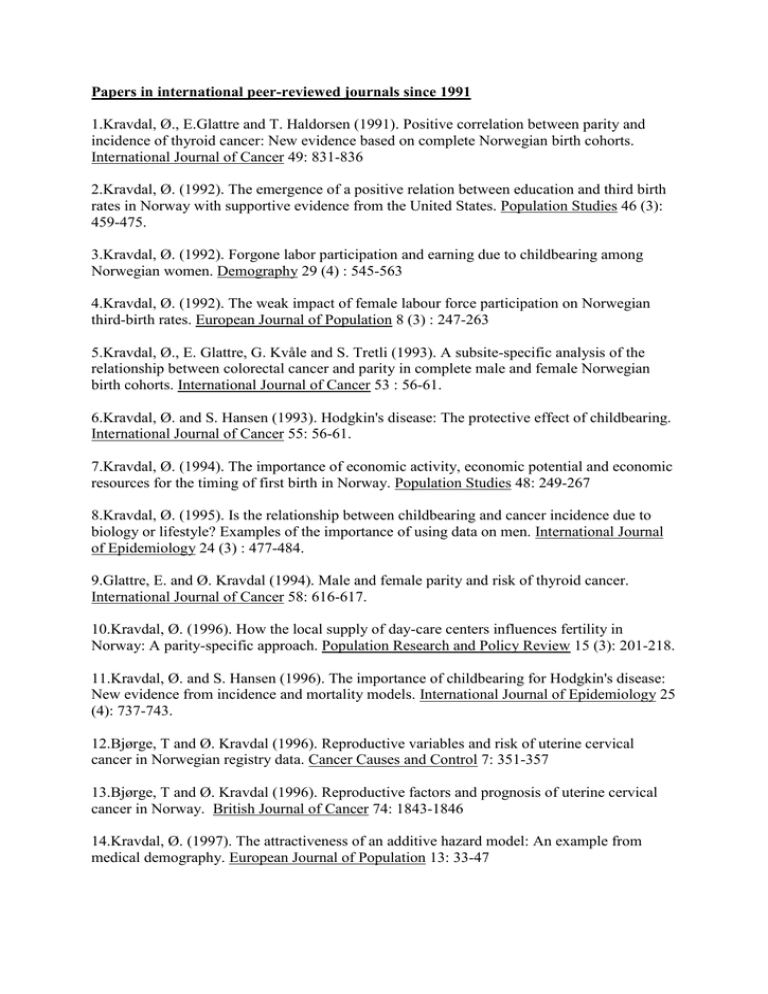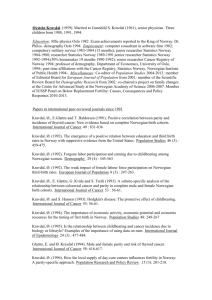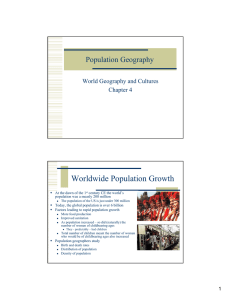Papers in international peer-reviewed journals since 1991
advertisement

Papers in international peer-reviewed journals since 1991 1.Kravdal, Ø., E.Glattre and T. Haldorsen (1991). Positive correlation between parity and incidence of thyroid cancer: New evidence based on complete Norwegian birth cohorts. International Journal of Cancer 49: 831-836 2.Kravdal, Ø. (1992). The emergence of a positive relation between education and third birth rates in Norway with supportive evidence from the United States. Population Studies 46 (3): 459-475. 3.Kravdal, Ø. (1992). Forgone labor participation and earning due to childbearing among Norwegian women. Demography 29 (4) : 545-563 4.Kravdal, Ø. (1992). The weak impact of female labour force participation on Norwegian third-birth rates. European Journal of Population 8 (3) : 247-263 5.Kravdal, Ø., E. Glattre, G. Kvåle and S. Tretli (1993). A subsite-specific analysis of the relationship between colorectal cancer and parity in complete male and female Norwegian birth cohorts. International Journal of Cancer 53 : 56-61. 6.Kravdal, Ø. and S. Hansen (1993). Hodgkin's disease: The protective effect of childbearing. International Journal of Cancer 55: 56-61. 7.Kravdal, Ø. (1994). The importance of economic activity, economic potential and economic resources for the timing of first birth in Norway. Population Studies 48: 249-267 8.Kravdal, Ø. (1995). Is the relationship between childbearing and cancer incidence due to biology or lifestyle? Examples of the importance of using data on men. International Journal of Epidemiology 24 (3) : 477-484. 9.Glattre, E. and Ø. Kravdal (1994). Male and female parity and risk of thyroid cancer. International Journal of Cancer 58: 616-617. 10.Kravdal, Ø. (1996). How the local supply of day-care centers influences fertility in Norway: A parity-specific approach. Population Research and Policy Review 15 (3): 201-218. 11.Kravdal, Ø. and S. Hansen (1996). The importance of childbearing for Hodgkin's disease: New evidence from incidence and mortality models. International Journal of Epidemiology 25 (4): 737-743. 12.Bjørge, T and Ø. Kravdal (1996). Reproductive variables and risk of uterine cervical cancer in Norwegian registry data. Cancer Causes and Control 7: 351-357 13.Bjørge, T and Ø. Kravdal (1996). Reproductive factors and prognosis of uterine cervical cancer in Norway. British Journal of Cancer 74: 1843-1846 14.Kravdal, Ø. (1997). The attractiveness of an additive hazard model: An example from medical demography. European Journal of Population 13: 33-47 15.Harvei, S. and Ø. Kravdal (1997). The importance of marital and socioeconomic status in incidence and survival of prostate cancer. Preventive Medicine 26:623-632. 16.Kravdal, Ø. (1997). Wanting a child without a firm commitment to the partner: Interpretations and implications of a common behaviour pattern among Norwegian cohabitors. European Journal of Population 13: 269-298 17.Kravdal, Ø. (1999). Does marriage require a stronger economic underpinning than informal cohabitation? Population Studies 53: 63-80 18.Kravdal, Ø. (2000). Social inequalities in cancer survival. Population Studies 54: 1-18 19.Fossaa, S.D. and Ø. Kravdal (2000). Fertility in Norwegian testicular cancer patients. British Journal of Cancer 82: 737-41 20.Kravdal, Ø (2000). A search for aggregate-level effects of education on fertility, using data from Zimbabwe. Demographic Research online at www.demographic-research.org/ Volumes/Vol3/3. 21.Kravdal, Ø. (2001) The impact of marital status on cancer survival. Social Science and Medicine 52: 357-368. 22.Kravdal, Ø (2001). Has population growth restricted improvements in per capita food availability, 1970-1995? Population Studies 55: 105-117. 23.Kravdal, Ø. (2001) Main and interaction effects of women’s education and status on fertility: The case of Tanzania. European Journal of Population 17: 107-136. 24.Kravdal, Ø. (2001). The high fertility of college educated women in Norway: An artefact of the separate modelling of each parity transition. Demographic Research 5: 187-21 25.Kravdal, Ø. (2002). The impact of individual and aggregate unemployment on fertility in Norway. Demographic Research 6: 263-294 26.Kravdal, Ø (2002). A cancer survival model that takes sociodemographic variations in ’normal’ mortality into account: comparison with other models. Journal of Epidemiology and Community Health 56 : 309-318 27.Kravdal, Ø. (2002). Education and fertility in sub-Saharan Africa: Individual and community effects. Demography 39: 233-250. 28.Kravdal, Ø. (2002). Is the increase in second- and higher-order birth rates in Norway and Sweden from the mid-1970s real or a result of inadequate estimation methods. Demographic Research 6: 241-262– AWARD FOR BEST PAPER IN THAT VOLUME 29.Kravdal, Ø. (2003). Children, family and cancer survival in Norway. International Journal of Cancer 105: 261-266. 30.Moursund, A. and Ø. Kravdal (2003). Individual and community effects of women’s education and autonomy on contraceptive use in India. Population Studies 57: 285-302. 31.Kravdal, Ø. (2003). The problematic estimation of “imitation effects” in multilevel models. Demographic Research 9: 25-40 32.Shkolnikov, V.M., Deev A.D., Kravdal, Ø and Valkonen T. (2004). Educational differentials in male mortality in Russia and Northern Europe. A comparison of an epidemiological cohort from Moscow and St.Petersburg with the male populations of Helsinki and Oslo. Demographic Research 10: 1-26 33.Kravdal, Ø. (2004). Child mortality in India: the community-level effect of education. Population Studies 58: 177-192 34.Kravdal Ø. (2004). An illustration of the problems caused by incomplete education histories in fertility analysis. Demographic Research S3: 135-154 35.Kravdal Ø. (2006). Does place matter for cancer survival in Norway? A multilevel analysis of the importance of hospital affiliation and municipality socioeconomic resources. Health and Place 12: 527-537 36.Kravdal, Ø. (2006). A simulation-based assessment of the bias produced when using averages from small DHS clusters as contextual variables in multilevel models. Demographic Research 15: 1-20 37.DeRose, L.F., and Ø. Kravdal. (2007). The effects of educational reversals on first births in sub-Saharan Africa: A dynamic multilevel perspective. Demography. 44: 59-78. 38.Syse, A., Ø. Kravdal and S. Tretli. (2007). Parenthood after cancer – A population-based study. Psycho-Oncology 16: 920-927. 39.Rindfuss, R.R. D. Guilkey, S.P. Morgan, Ø. Kravdal, B.K. Guzzo. (2007). Child care availability and first birth timing in Norway. Demography 44: 345-372. 40.Kravdal, Ø. (2007). A fixed-effects multilevel analysis of how community family structure affects individual mortality in Norway. Demography 44: 519-536. 41.Syse, A. and Ø. Kravdal (2007). Does cancer affect the divorce rate? Demographic Research 16: 469-492. 42.Kravdal, Ø. (2007). Effects of current education on second- and third-birth rates among Norwegian women and men born in 1964: Substantive interpretations and methodological issues. Demographic Research 17: 211-246. 43.Kravdal, Ø. (2008) A broader perspective on education and mortality: Are Norwegian men and women influenced by other people’s education? Social Science and Medicine 66: 620636. 44.Grundy, E. and Ø. Kravdal. (2008). Reproductive history and mortality in late middle age among Norwegian men and women. American Journal of Epidemiology 167: 271-279. 45.Kravdal, Ø. (2008). Does income inequality really influence individual mortality? Evidence from a ‘fixed-effects analysis’ where constant unobserved municipality characteristics are controlled. Demographic Research18: 205-232. 46.Kravdal,Ø. and R.R. Rindfuss. (2008). Changing relationships between education and fertility – a study of women and men born 1940-64. American Sociological Review 73: 854873 47.Syse, A. Ø. Kravdal, S. Tretli (2008). Cancer’s impact on employment and earnings – a population-based study from Norway. Journal of Cancer Survivorship 2: 149-158. 48.Syse A, Tretli S, Kravdal Ø. (2009). The impact of cancer on spouses’ labor earnings – a population-based study. Cancer September 15 volume: 4350-4361. 49.Steele, F., W.Sigle-Rushton and Ø. Kravdal. (2009). Consequences of family disruption on children’s educational outcomes in Norway. Demography 46: 553-574. 50.Kravdal, Ø. (2009). Mortality effects of average education in current and earlier municipality of residence among migrants, net of own education. Social Science and Medicine 69: 1484-1492. 51.Kravdal Ø. (2009). Mortality effects of average education: A multilevel study of small neighbourhoods in rural and urban areas in Norway. International Journal for Equity in Health 8: 41. 52.Kravdal Ø. (2010). Demographers’ interest in fertility trends and determinants in developed countries: Is it warranted? Demographic Research 22: 663-690. 53.Grundy E and Ø Kravdal. (2010). Fertility history and cause-specific mortality: a registerbased analysis of complete cohorts of Norwegian women and men. Social Science & Medicine 70: 1847-1857. 54.Rindfuss R., D. Guilkey, S.P. Morgan, Ø. Kravdal (2010). Child care availability and fertility: Norway. Population and Development Review 36: 725-748. (American Sociological Association AWARD FOR BEST PAPER in the field of Sociology of Population 2010.) 55.Kravdal, Ø. (2010). Effects of community education on individual mortality: A study based on longitudinal multilevel data for 1.7 million Norwegian women and men. Journal of Epidemiology and Community Health 64: 1029-1035. EDITOR’S SELECTION that month. 56.Kravdal Ø. (2011). Fixed effects analysis no quick fix but still a step in the right direction and better than the suggested alternative. Journal of Epidemiology and Community Health 65:291-292 57.Kravdal Ø. and I. Kodzy. (2011). Children’s stunting in sub-Saharan Africa: Is there an externality effect of high fertility? Demographic Research 25(18): 565-594. 58.Cohen, J. Ø. Kravdal, N Keilman. (2011). Childbearing impeded education more than education impeded childbearing in a cohort of Norwegian women. Proceedings of the National Academy of Science 108(29):11830-5 59.Syse A, T Lyngstad and Ø Kravdal. (2012).Does survival after childhood cancer depend upon parents' social or economic resources? A population-based study. International Journal of Cancer 130: 1870-1878. AWARD FOR BEST NORWEGIAN EPIDEMIOLOGY PAPER 2011. 60.Shkolnikov VM, EM Andreev, DA Jdanov, D Jasilionis, Ø Kravdal, D Vågerø, T Valkonen. (2012). Increasing absolute mortality disparities by education in Finland, Norway and Sweden, 1971-2000. Journal of Epidemiology and Community Health 66: 372-378. 61.Elstad, J-I, Torstensrud R, Lyngstad TH, Kravdal Ø. (2012). Trends in educational inequalities in mortality, seven types of cancers, Norway 1971-2002. European Journal of Public Health 22: 771-776 62.Kravdal, Ø., E. Grundy. T. Lyngstad, and K.Aa. Wiik. (2012). Family life history and late mid-life mortality in Norway. Population and Development Review 38: 237-257. 63.Berntsen K. and Ø. Kravdal. (2012). The relationship between mortality and time since divorce, widowhood or remarriage in Norway. Social Science and Medicine 75:2267-2274. 64.Kravdal. (2012). Further evidence of community education effects on fertility in subSaharan Africa. Demographic Research 27: 645-680. 65.Kravdal, Ø. (2013). The poorer cancer survival among the non-married in Norway: Is much explained by comorbidities? Social Science and Medicine 81: 42-52. 66.Kravdal, Ø., I. Kodzi and W. Sigle-Rushton. (2013). Effects of number and age of siblings on educational transitions in sub-Saharan Africa. Studies in Family Planning 44: 275-297. 67.Kodzi, I and Ø. Kravdal. (2013). What has high fertility got to do with the low birth weight problem in Africa? Demographic Research 28: 713-732. 68.Bævre K and Ø Kravdal. (2014). The effects of earlier income variation on mortality: An analysis of Norwegian register data. Population Studies 68: 81-94 69.Sigle-Rushton, W., T. Lyngstad, P. Lie Andersen and Ø. Kravdal. (2014). Proceed with caution? Parents’ union dissolution and children’s educational achievement. Journal of Marriage and the Family 76: 161-174. 70.Kravdal, Ø. (2014). The estimation of fertility effects on happiness: Even more difficult than usually acknowledged. European Journal of Population 30: 263-290. 71.Grundy E and Ø. Kravdal. (2014). Do short birth intervals have long-term implications for parental health? Results from analyses of complete cohort Norwegian register data. Journal of Epidemiology and Community Health 68: 958-964 72.Kravdal, Ø. Grundy E. (2014). Underuse of medication for circulatory disorders among unmarried women and men in Norway. BMC Pharmacology and Toxicology 15:65 73.Kravdal Ø, Grundy E, Skirbekk V. (2015). Associations between fertility history and midlife depression: a register-based analysis of Norwegian women and men. Forthcoming in Aging and Mental Health. 74. Kravdal Ø, K. Alvær, K. Bævre, J.M. Kinge, J.R.Meisfjord, Ó.A. Steingrímsdóttir, B.H. Strand. (2015). How much of the variation in mortality across Norwegian municipalities is explained by the socio-demographic characteristics of the population? Health & Place 33: 148-158 75. Kinge J.M., Ó.A. Steingrímsdóttir, B.H. Strand, Ø. Kravdal (2016). Can socioeconomic factors explain geographic variation in overweight in Norway. Forthcoming in SSM – Population Health Submitted 76. Kravdal, Ø and E. Grundy (2016). Health effects of parental deaths among adults in Norway. 77. Kravdal, Ø. (2016) Expected and unexpected consequences of childbearing – a methodologically and politically important distinction that is overlooked.






